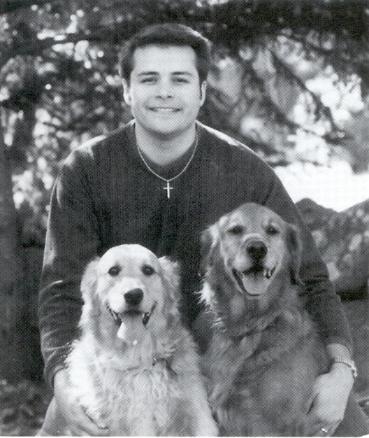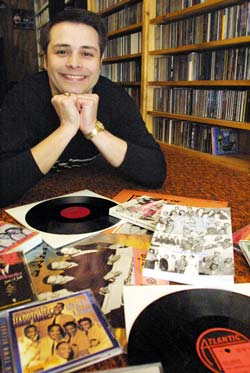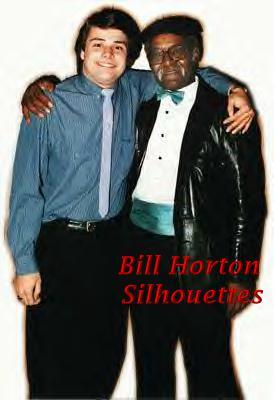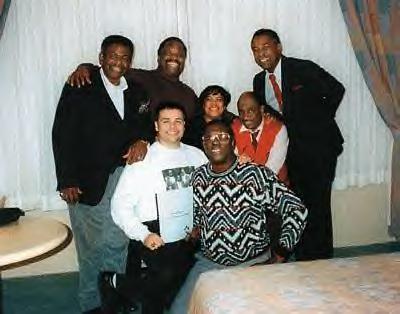|
|
|
"GROUP HARMONY:
![]()
ECHOES OF THE RHYTHM AND BLUES ERA"
![]() By
Todd Baptista
By
Todd Baptista ![]()
![]()
B
Todd R. Baptista's interest in rhythm and blues music and writing has been lifelong His literary works which document the history of rhythm and blues have appeared in Goldmine, Echoes Of The Past, and in the liner notes for various compact disc reissue projects over the past decade. Mr. Baptista's first book, Group Harmony: Behind The Rhythm And The Blues, was published in 1996. In addition to his literary efforts, he has co-produced concerts, hosted radio programs featuring vocal group harmony pioneers, and aided artists in collecting long overdue royalties. A graduate of Massachusetts College of Pharmacy and Allied Health Sciences, Mr. Baptista is a clinical pharmacist, practicing in Wakefield, Rhode Island. An avid music collector, Todd and his wife Kristen reside in Westport,
Ma. Massachusetts.
![]()

For those of us in a certain age bracket --
old enough to remember Fabian, yet young enough to wonder why -- 1950s music is
inextricably linked to our early teenage years. In my case, it
provided the soundtrack for all of those awkward first steps towards
adulthood. My first clumsy date -- for which the best that can be
said is nobody died.
My first heart-thumpin', pheremone-churnin', hand-tremblin', lip-quiverin' kiss,
which unfortunately landed somewhere near the intended target's left eye. My
first armed robbery.
Naw, just kidding -- but it serves to illustrate how those long-ago rock
'n' roll tunes continue to influence, at least in some small measure, the
grown-up I now pretend to be. ![]() God, it was fun stuff.
God, it was fun stuff.
Elvis. Chuck Berry. Bill Haley and
the Comets. Little Richard. Buddy Holly and the Crickets. The Everly Brothers.
Bo Diddley.
![]()
Nothing to which today's kids listen
seems anywhere near as good-natured or goofy. However, much of the most fondly
remembered music of that pre-Beatle "I Like Ike" era was not
technically rock 'n' roll at all. Some of the better tunes were an
infectious confection of glorious, inner city, mostly black, "street-cor![]() ner"
vocal harmonies cascading over nonsensical lyrics in ever-inventive and joyous
permutations.
ner"
vocal harmonies cascading over nonsensical lyrics in ever-inventive and joyous
permutations.
The Drifters. The
Cadillacs. The Spaniels. The Moonglows. The Cardinals. The Spiders. And on, and
on, and on ...
![]()
Great stuff, all. For
those, like me, trapped in braces and hopelessly riddled with acne, their songs
dealt with all the essentials.
![]() Girls ... cars ...
girls ... love ... girls.
Girls ... cars ...
girls ... love ... girls.
![]()
And who among us will ever
forget those masterful lyrics? Take "Get a Job" by The Silhouettes,
for example:
![]() Baaaa dip dip dip dip, yip yip yip
yip, moom moom moom moom ...Get a job.
Baaaa dip dip dip dip, yip yip yip
yip, moom moom moom moom ...Get a job.
![]() Bada da da, dada bada bum ...
Bada da da, dada bada bum ...
![]()
![]()
|
|
Todd, Gerald Gregory and Kristen |
I always called it "doo-wop" music. That is, until I met Todd Baptista four or five years ago, after he had written his terrific first book, "Group Harmony: Behind the Rhythm and the Blues." This Westport man, I soon learned, is the world's biggest fan of this particular style of music ... and he never refers to it as anything other than rhythm and blues. Ever.
Indeed, mention the term
"doo-wop" in his presence, and his good-natured smile freezes in
place.
OK ... So R & B it is.
Now Todd's written his second book on the subject, "Group Harmony: Echoes of the Rhythm and Blues Era," and it, too, is a corker -- equally detailed, equally impressive. It's easy to write about something one adores, Todd intimates. For him, these self-published books are a total labor of love from start to finish. It shows.
|
|
Todd with Tony Middleton and the Willows |
Both books are a wonderful treat
for anyone who loves this type of music, and for this Todd credits Kristen, his
wife of nine years. Most times she accompanies him on his interviews and various
fact-finding missions, serving as a sort of combination right-hand person/muse.
"Anything that allows you to
spend more time with your best friend is in your best interests," Todd
reasons with a knowing smile. "She's allowed me to indulge my passion in
this music ... the writing ... the radio show. Who else would have allowed me to
d![]() o an overnight radio show every other
week?" he asks. Since the first book's publication, Todd explains, he
and his dad Randy have become the first -- and as far as is known, the only --
father-son rhythm and blues DJ team.
o an overnight radio show every other
week?" he asks. Since the first book's publication, Todd explains, he
and his dad Randy have become the first -- and as far as is known, the only --
father-son rhythm and blues DJ team.

![]()
Every other Tuesday, from 2 to 5 a.m., Randy and Todd are at WATD in Marshfield plying their passion and helping to keep the rhythm and blues tradition alive. "As a boy I grew up listening to all those records," Todd says reverently. "Initially, it was a bonding process with my parents (Randy and Carol Baptista) -- especially my father." And with this radio gig, it still is.
Make no mistake, for Todd Baptista rhythm and blues is a full-time quest. Nearly every night and weekend away from his job as a clinical pharmacist in Rhode Island is spent researching or writing about the music he so dearly loves. It is all-consuming, laughs Kristen, a nurse at Rhode Island Hospital. "Todd has had to be not only a writer, but in some cases a private detective to track down many of the book's subjects."
But if the road has been a long one, thanks to
Todd's persistence and expertise there have been many heart-warming moments
along the way. One of my favorites of the numerous stories the Baptistas
impart is that of The Willows, a group of five black teenagers from Harlem who
hit the upper reaches of the charts in the late '50s with their wonderful
"Church Bells May Ring."
The Willows' music made millions -- but
not for The Willows.
![]()
As so often happened in that time, the money always seemed to end up in the pockets of unscrupulous promoters, handlers, managers and lawyers. Broke and discouraged, the group disbanded years ago, and it was only after much painstaking research that Todd was able to track down Richie Davis, one of the four remaining original members. "One of my fondest wishes is that I could have seen you perform," the 27-year-old man told him. Won over by Todd's sincerity, not only did Richie David consent to an interview, but he brought along his former bandmates, as well.
Long story short, the resulting publicity when the book was finally published -- coupled with the author's constant prodding -- served to reignite the group's dormant career. The Willows -- thanks to Todd Baptista -- again started to perform regularly, culminating in what he calls "one of the greatest nights of my life -- pure magic."
Todd still pinches himself that he was able to gather a bus-load of fans from his Marshfield radio show and escort them to New York City for a "one of a kind" rhythm and blues concert where he emceed many of the classic '50s R & B acts.
The highlight of the evening turned out to be the "comeback" of The Willows, and Todd says he, for one, will never forget it. "I had goose-bumps," he says in a voice tinged with awe. "Here I was, this 27-year-old white kid taken in by all these black performers ... in their 60s, 70s and sometimes even their 80s. I was spurred on by the knowledge that their kids would never know what their parents and their grandparents had done ... that they had had hit records ... that they had made movies. They'd never know their legacy if somebody didn't document it. That's incredible to me."
Much of the research -- and the
rewards -- for this second book have given him quite similar feelings, he adds.
The greatest part of the whole process, by far, the admittedly star-struck
author says, is that many of the people he idolized as a little boy are now
among his greatest friends![]() "What a
wonderful gift that is." It gives him great satisfaction, Todd
adds modestly, that he's been able to bring about a resurgence of interest in
many of these 40- and 45-year-old groups.
"What a
wonderful gift that is." It gives him great satisfaction, Todd
adds modestly, that he's been able to bring about a resurgence of interest in
many of these 40- and 45-year-old groups.
"I made a vow that if my book ever made money, 40 percent of all the
profits would go to the artists who participated in it."
![]()
The first book was a hit, selling
out its initial printing, and Todd Baptista has kept his promise.
"It continues to amaze me," he says, "that the royalty checks, no
matter how small or meager they might be, are in many cases more money than
these artists initially received for recording million-sellers."
That, he says with disgust, is a
crying shame -- and an inequity he is determined to redress.
"To say they got ripped off is the understatement of all time."
![]()
Story
by Hank Seaman ![]()
![]()
There is a photo in Todd Baptista's new
book, "Group Harmony: Behind the Rhythm and the Blues." Shot in 1989,
the picture captures the author and Bill Horton, lead singer for the
Silhouettes, the group who sang "Get a Job." Mr. Baptista was 21
when the picture was taken. Mr. Horton, who died last year, was 59. Their arms
circle each other's shoulders. You can't see Mr. Baptista's feet, but it's a
good bet they weren't touching the floor.
The photo, snapped by the author's wife, Kristen Baptista, illustrates a love
story. The young man has adored the songs sung by the old man and his
contemporaries for so long, calling him a fan misses the point.
As far back as he can remember, Mr. Baptista has been a captive of the
music that gave birth to rock 'n' roll. In a much earlier photo, taken when he
was 5, he holds a Little Richard album and beams.
That passionate bond fueled the intense research at the heart of his book, an
ode to the voices of R&B. Among the 10 groups profiled are the Spaniels, El
Dorados, G-Clefs and Harptones.
![]()
Mr. Baptista, a full-time pharmacist at CVS in Fairhaven, published the book himself last month. He paid for the printing, done in Rhode Island, by "dipping into the 401K." It cost him $10,000 for 1,000 copies. He estimates spending another $5,000 in seven years of off-and-on research. During that time, the Baptistas were frequently off to New York, New Jersey and beyond, going to oldies concerts, tracking down group members and often growing close to them.
They still hit the road whenever they have a weekend free, catching concerts and maintaining ties. "I've gotten to meet and form friendships with the idols of my youth and of my father's youth. That's really a special gift," Mr. Baptista says, wearing a G-Clefs T-shirt and sitting across from his wife at their dining-room table. At times, it was difficult gaining the trust of his subjects. These are, after all, some of rock's worst casualties -- in many cases lied to, swindled, discriminated against, used and forgotten by the music industry.
And so, the author, 28, suffered
"tons of wasted research" when groups opted out, sometimes at the last
minute. ![]() He's able to forgive. "I
can't find fault with someone for not talking with me. I don't know how they
might have been ripped off." "A lot of times (at concerts), I
would sit and listen to these groups and cry just seeing them and knowing what
they went through," he says. "A lot of them don't even own copies of
their own records. You wouldn't believe how many tapes I've made for them."
He's able to forgive. "I
can't find fault with someone for not talking with me. I don't know how they
might have been ripped off." "A lot of times (at concerts), I
would sit and listen to these groups and cry just seeing them and knowing what
they went through," he says. "A lot of them don't even own copies of
their own records. You wouldn't believe how many tapes I've made for them."
The book's 220 pages are divided into 10 chapters, one for each group. The author constructs highly detailed histories of the groups' journeys from obscurity to fame, and -- all too often -- back again. Each chapter contains photos, a discography and notes on unreleased recordings. The book is filled with quotes from the music-makers and others. Mr. Baptista's research built files 3 inches thick on each group.
Asked why he focused only on men, he points out that his subject, R&B in the 1950s and early '60s, was overwhelmingly a male domain. But there were female groups, among them the Hearts, the Bobbettes, and Lillian Leach & the Mellows. If he writes a sequel, they'll be part of it.
Densely packed with names, dates and places, "Group Harmony" is not for the casual fan. It is a book for R&B devotees, and it may be an important one. Other books mention the groups Mr. Baptista has profiled, but none apparently in such depth. So far, the book is selling largely in vintage record stores like Relic Record Shop in Hackensack, N.J., billed as "the oldest operating oldies store in the country." George Lavatelli, the store's owner, told Mr. Baptista, " 'I have people who have to have this book.' "
For a self-published work, "Group Harmony" is doing very well: 300 copies sold in the first month. On April 13, a few days after the printing, Mr. Baptista was in Manhattan, autographing copies at the 6th annual United in Group Harmony Association (UGHA) Hall of Fame award ceremony, UGHA President Ronnie Italiano, owner of Clifton Music in Clifton, N.J., used his shop's most recent newsletter to praise the book: "Todd is a young RnB enthusiast, whose knowledge and appreciation for the music is thoroughly expressed in his writings. Interesting reading! Highly recommended! A must for all into RnB vocal group harmony music!"
The author first tried the
agent/publishing house route, but quickly changed his mind. For one thing,
people told him a publisher would want more recognizable groups. Doing it
himself also meant complete control over content and design. Finally,
there was the issue of getting it done while the singers, many getting on in
years, were still around. "I wanted as many of them as possible to enjoy
it." That's because, quite simply, he wrote the book for them. "I
really enjoy hearing them say, 'Somebody finally told our story.' That's my
reward."
![]()
He showed the groups his work before it went to press to make sure they were comfortable with it and that there were no errors. If the book turns a profit, 40 percent of it will go to the singers. "I don't think a lot of them realize how much happiness they've brought to us," he says.
Mr. Baptista can tell you the moment he fell in love with the music. It was 21 years ago in the back seat of his parents' station wagon, on a Sunday afternoon.In the book's introduction, he recalls, "It was on a winding country road somewhere, when I heard him (deejay Chuck Stevens) introduce and play the Silhouettes' 'Headin' for the Poorhouse.' ... As a 7-year-old, it changed my entire picture of the long-passed but not so forgotten first generation of rock 'n' roll. This music was unlike the hard sound of the early 1970s. It was simple. It was honest. It had come first. And I wanted more."
His parents took him to oldies shows in Providence in the mid '70s. "My mother would bring a pillow so I could see over the person in front of me." To Todd's ear, R&B sounded more raw, more authentic, than the popular music of his own youth. It excited him. Both of his parents helped with the book. Carol, his mom, is a former English teacher. His father, Randy, is an engineer. "She's responsible for all the commas in the book," Todd says of Carol.
But the book owes its existence to Randy and the passion he communicated to his young son. Todd recalls his father excitedly thumbing through "Record Exchanger" magazine. He remembers hunting for obscure records in music stores. "I can still hear him finding something and saying, 'This is the one!' " That's why Todd dedicated the book in part to him, "for keeping the music alive so that it could reach my ears and from whose editorial skills bloomed the fruits of my labor."
His parents hosted a coming out party for the book a week after it was published. William "Dicey" Galloway, an original member of the Harptones and a one-time New Bedford resident, was there. He sang to one of his songs on a jukebox at Todd's parents' home.
The book got its start in 1989 when Mr. Baptista was
a full-time student at the Massachusetts College of Pharmacy in Boston. He
landed a part-time job taking pictures at concerts for a rock show promoter.
Through the contacts he made, he soon found himself writing brief group
biographies for "Gold Mine" and "Echoes of the Past"
magazines and the short-lived Doo-Wopp Hall of Fame of America.
(This wasn't his first writing experience. He covered the Seekonk Speedway for
local newspapers before heading to college in Boston.)
![]()
He graduated in 1990, started work as a pharmacist, and kept writing. The articles didn't pay anything, but gave him great satisfaction. He was gaining recognition for men who'd been taken advantage of and who'd given him such joy. "I wanted it to be said that these articles were the most accurate, complete thing that's been written about them," he recalls. "I wanted the artists to be able to say to their families: This is the way it was."
Originally, he planned a simple discography, but expanded the project when he realized that would just be recycling material already out there. "I found myself drawn to the real story, to the men who made the music. That no one had ever given them a chance to tell their story stunned me." Suddenly, he had a totally different book on his hands. Along the way, Kristen, 27, became key to the project: taking photographs, providing support to her husband and to the singers, falling in love with the music. Like her husband, she exudes an intensity and freshness. The two don't smoke, drink or eat beef. But, says Todd, "We work hard and play hard." It's easy to see how the singers might have been charmed by the couple's quiet confidence and determination. They seem a hard pair to say no to.
Kristen works as a cardiac nurse at Rhode Island Hospital in Providence. The fact that she's a nurse and he's a pharmacist has meant that more than once they've sat with aging R&B singers while the artists took out their pills and eyedrops and asked questions about interactions. Mr. Baptista sometimes wishes he could involve himself with the music full time. "But it's only because of my pharmacy job that I can travel and meet these people and publish this book," he says. Kristen has her own strong personal pursuits, some of which she's drawn Todd to. One is Walt Disney. The couple named one of their two dogs Nala (a character in "The Lion King"). Framed cells from "Aladdin" and "Song of the South" hang in their living room.
Another passion of hers for a while was photographing rock stars up close, in concert (not necessarily with permission). One wall of the couple's basement is filled with her shots of such people as Elton John, Tina Turner and Bruce Springsteen. Not far away are shelves of CDs and records and a display case filled with Beatles memorabilia. Not surprisingly, the Baptistas love rock most directly influenced by the R&B groups of the 1950s. The couple points out that most of their friends share their musical taste, which seems strange until you find out that most of them are their parents' age.

The author is taking time off from research and writing, but he knows there are other books to be written. "There are lots of groups (including those with women) whose stories haven't been told." When Bill Horton died last year, the Baptistas went to his funeral in Philadelphia. They had grown close to him, and his death had a profound effect on Todd. He has a difficult time talking on the phone to Mrs. Horton. The Silhouettes, Mr. Horton's group, are putting out a new CD, filled mostly with songs recorded shortly before Mr. Horton died. Mr. Baptista will write the liner notes.
"Even to this day, I can't put on his music. It's hard," the pharmacist/R&B historian says, his voice trailing off, his eyes taking on a distant look. Maybe he's reflecting on the fact that he will see all the men behind the rhythm and blues die in his lifetime. But soon, he brightens, a broad smile breaking across his face as he recalls a ride he and Kristen gave the Silhouettes in their car a few years ago. During the drive, the group broke into song. It was the last time the original Silhouettes ever sang together. And the song was "Headin' for the Poorhouse," the tune Mr. Baptista first heard sitting in the back of his father's car.
![]()
![]() "Group Harmony: Behind The
Rhythm and The Blues" is available for $19.95 at Baker Books in Dartmouth.
You can also get it by mail: Send a check for $22 to TRB Enterprises, PO Box
50962, New Bedford, MA 02745.
"Group Harmony: Behind The
Rhythm and The Blues" is available for $19.95 at Baker Books in Dartmouth.
You can also get it by mail: Send a check for $22 to TRB Enterprises, PO Box
50962, New Bedford, MA 02745.

Photos by Kristen Baptista
Todd Baptista of Westport, in the white shirt above, is surrounded by members of
the Harptones, one of the subjects of his self-published book.

Staff photo by Hank Seaman
Todd and Kristen Baptista display some of the albums containing their cherished
music.
|
|
|
|
![]()